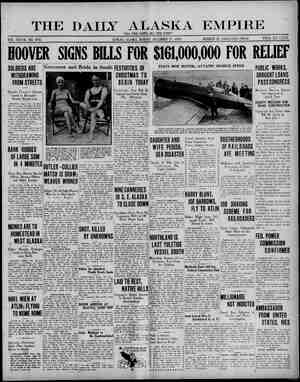Evening Star Newspaper, December 21, 1930, Page 82
You have reached the hourly page view limit. Unlock higher limit to our entire archive!
Subscribers enjoy higher page view limit, downloads, and exclusive features.
¢ The Nuts That You Eat at Christmas N - Time By John Frazier. Many of the Favorites Are Truly American. Others Come From All Over the World. BY JOHN FRAZIER. HE nuts that you eat at Christmas tume, that old Santa puts into the children’s stockings as they hang row on row on Christmas eve on the man- telpieces of the country and on church Christmas trees—where do they come from? What is their history? And how did they get .80 ‘this country? For not all the nuts that hdpmmmeholmysnghdsome time of glowing embers, childish laughter and elder -joy -with their hulls filying around the hearth- stone, are native to America. Oh, no! Only a few. “The English walnut, the almond and the fil- bert, three of the most delightful and meaty nuts for Winter enjoyment, are not native to ‘America, though grown here extensively in various parts of the country. And, the Eng- Colonists quired no cooking, It bore the name in those immemorial times of “the food of the gods,” and from Jovis is its generic name traced today from juglans, the name given it by of modern times. 5 Roman civilization burst its bonds Agricultural older part of the city.” The English walnut, descendants of the early transpian 8 ound today all through Maryland, Virginia, Delaware, New Southwestern Pennsylvania, espe- wherever they did come from, they were of fine stock. For over 30 years seed from his stock were used in developing the English walnut industry on the West Coast. IT for the English walnut industry in ! the Northwest goes to & Frenchman by the name of Felix Gillette, who, some 10 years after Sexton’s purchase in California, brought to this country from France seed which he grew in a nursery and grafted on to native stock. His ‘work resulted fn establishing the English wal- mit in Central and Nerthem California;, North- west Orcgon and Southwest Washington. The greotest produetion of “thé“ niut les, however, st in Sou‘*hern California, where best results are had quite near the Pacific Ocean, in the four or five counties in the immediate neigh- borhood of Los Angeles. About 1900 serious study was begun of the English walnut by ‘Those Spanish friars, sailing the main to the New World, living a cloistered intellectual life, disseminating Spanish civilization and Old World culture, brought to their new home, s0 like their old climatically, fruit and nuts and vines, their pastimes in their hours of leisure from their beads and devotions, And they aght the pungent almond from the Mediter- el the appearance of fereign varieties, notably the Jordan, the highest priced of all the almonds. The blossoming almond is ore of the most beautiful things in nature. Only the apple i . Elfig 35§ Dr. Whitehouse tr;;i:ing' an examination of puuche nuts collected in Pe by the Department of Agriculture. THE SUN'DAY; STAR, WASHINGTON, D. C, DECEMBER 21, 1930. rsia *that may be now on through the Winter the shrill whistle of the chestnut vendor may be heard throughe out the confines of the city. But nol for long, unless science can find some method of com= bating the disease that has been sweeping the sl fF A‘rt.besa.mcummthevepamnenzdu- riculture has been laboring to preserve this nut tree to America by the introduction of Chi- nese varieties so have individuals. Within the . last few weeks the department has procured nuts from chestnut trees in the Orient for exam- ination and, out of several hundreds, & number )nnbeenlonndthatmhr:emdmymet —in some cases more so than the native Amer- jcan nut. Today there is no important orchard production of chestnuts in this country. But in all probebility varieties will be developed by individuals or the Government which will re- pjlace production of chestnuts again in the East. Arvother native nut worthy of mention is the butternut. This is native in the North- eastern States. Although little more than a forest species to date, in so far as improvement by horticultural methods is concerned, it has certain features greatly in its favor. It grows . farther north than the black wainut or any of the hickories. The young trees are rapid grow- ers and come into bearing early. Butternut “trees thrive best in fertile, moist soils, such'as usually found in valleys and lowlands adjacent to streams throughout the North and North- east. Prices for butternut kernels are rela- tively high and the supply is limited. ‘The Persian or English walnut, as we know #t, has never gained a foothold on the East, though, as outlined at the beginning of this article, it has been a native of this part of the country ever since the days of the colonists. De- spite this fact, plantings of a dozen or more trees around dooryards is not an unfamiliar sight. Put out on proper soil and cared for properly, they yield a profitable return and serve an ornamental purpose as well. In the immediate vicinity of Washington and the Di<- trict of Columbia the trees are more often to be found, perhaps, in the towns and on farm residence grounds from the Chesapeake and Delaware Bay region westward into Northern Maryland and Southern Pennsylvania to the Alleghenies, than elsewhere in the ccuntry east of the Rocky Mountains. Today, through its foreign plant introduction office, the Department of Agriculture is scour- ing the world in the search of nut-bearing trees 3 lanted to American soil and will thrive here. y last year two setientists of this office, H. L. Westover and W. E. White- ‘house, traveled ly through Southern x:n mm and fruits for introduction imte ca.

